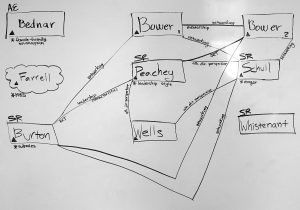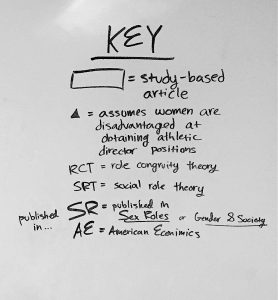Here it is as promised! The comprehensive view of how my sources relate to one another. 
I initially thought my research paper would be something about the lack of women in leadership. It did end up that way, but as I was researching I found way more than I expected on the barriers to women becoming athletic directors. I figured there would be limited information on the such a specific subject so I was prepared to broaden my research question. In fact, though I did not need to. I ended up with enough information to address the barriers women encounter which result in a lack of women athletic directors.
something about the lack of women in leadership. It did end up that way, but as I was researching I found way more than I expected on the barriers to women becoming athletic directors. I figured there would be limited information on the such a specific subject so I was prepared to broaden my research question. In fact, though I did not need to. I ended up with enough information to address the barriers women encounter which result in a lack of women athletic directors.
The Triangles
Though often dissimilar in the barriers they explore, these sources use the assumption that women are disadvantaged from achieving athletic director positions, with the exception of Whistenant (in 2003) who actually aims to prove this assumption in addition to discussing Title VII (which none of the other authors mention). I noted this with a black triangles in the bottom left corner by the author’s names.
Networking
The barriers explored within the conversation range from leadership style to lack of networking to lack of good mentorship. My sources came to no consensus on which factors are most important and some even failed to find a significant effect of their factor on athletic directors. However, there was some agreement that the lack of networking opportunities for women is a significant barrier.Namely, Burton, Bower (in both of his articles) and Schull identified this as a barrier to women in the sports management field. Schull’s case study revealed an extensive amount of gendered-politics behind one merger of women and men’s athletic departments. Though she never explicitly states that networking is a factor, the existence of the two competing groups in the study, referred to as “the posse” and “the brotherhood”, are evidence in themselves that networking has an impact on whether women are hired as athletic directors.
